Arrival in Luang Prabang
January 12th 2010 – Published: January 14th 2010
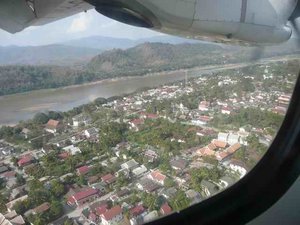
Nellie and Monk arrived in the Lao Peoples’ Democratic Republic at 15:10 onboard the Bangkok Airways twin-engined turboprop. The descent into Luang Probang is a bit bumpy but it’s worth it for the view of the town below and the Mekong River running beside it.
Immigration is a very Communist process. To get a visa on arrival, one has to queue at the first of 2 windows, each manned by a very serious-looking official. The first window takes one’s passport and visa application and passes these to the ‘back-office’ staff. One then queues at the 2nd window until the visa-endorsed passport arrives from the back office. After handing over US$35, Monk found himself in possesion of a 30-day visa for the Lao PDR. The visa is quite the most ornate Monk has ever seen – well worth the money. Monk used the spare US dollars he had in his possesion after enquiring the cost of the visa in Thai baht. A quick calculation of the exchange rate convinced Monk to part with his US dollars and use the extra baht he’d effectively gained for a beer or two when he gets to Thailand. The price of the visa seems to be a very partisan affair and varies according to the politics/sympathies of the country one resides in – needless to say, US$35 is the most expensive visa price. No visa was needed for Nellie; being an elephant, they obviously assumed she was a Lao national. An early name for Laos in the 14th century was Lan Xang – ‘The Land of a Million Elephants’. Today, estimates put the number of elephants at just around 2000. With Nellie’s arrival, the population has increased by one small elephant.
After a short drive into town, Nellie and Monk arrived at the hotel they’d booked. The Apsara bills itself as a ’boutique’ hotel and ‘The Most Chic Place in Town’. It’s a pleasant-enough place to stay for a few days, in a convenient location, close to the town centre. The hotel has a terrace beside the River Khan (the Nam Khan).
Eating and drinking
Monk and Nellie did a quick scout around town and decided to try the local Lao beer – called – Beerlao. The Lao are rightly proud of the quality of their state-produced beer. At heart, Monk is a bitter drinker but he does appreciate a good lager when he finds one. There is apparently a dark version of Beerlao which he hopes to report on in a subsequent blog.
Later, after making themselves presentable, Nellie and Monk went off to dine. It was all a bit of a rush finding a restaurant that was still open that looked as though it might serve authentic Lao cusine but they came up trumps. Eating later than 20:30 to 21:00 seems to be a problem in Luang Prabang.
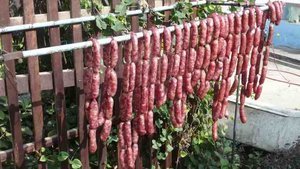
Monk ordered tam maak-hung to start. This is shredded, unripe papaya with a very hot chilli dressing. Sausages are a speciality of Luang Prabang so Monk ordered these together with the almost-obligatory sticky rice, khao niaw.
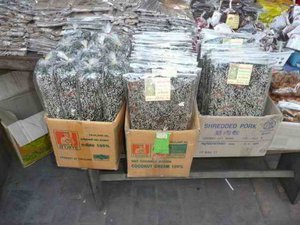
He also ordered khai paen – fried river moss from the Mekong served with the local jaew bawng dip of chillis mixed with dried buffalo skin. The sausages never arrived but Monk was glad because the other dishes were more than he could eat. The river moss was very good and Monk shared it with the inquisitive people on the next table. See the picture of the river moss in the local market. It’s coated in sesame seeds and looks a bit like a sheet of sandpaper in its uncooked state.
To round things off, Monk thought he’d try the local rice whisky called lao-lao (the brand consultants obviously put a lot of thought into that name). Monk likes to try the local hooch wherever he goes and the lao-lao is – er – interesting! It’s a bit sweet and is like a very strong version of rice wine.
Exploring Luang Prabang
January 13th 2010 – Published: January 15th 2010
Nellie and Monk decided to spend the day exploring Luang Prabang on a walk set out by Monk’s trusted Lonely Planet guide. The walk was supposed to take 4-6 hours but, after 6 hours, Monk and Nellie had only completed half of it. There were so many intersting diversions.
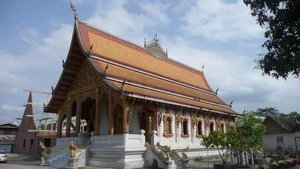
Luang Prabang has literally dozens of temples known as wats. Unlike wats in some other places, almost every one that Nellie and Monk visited was full of monks going about their business. That’s not really so surprising because there are probably thousands of monks in this town. It’s quite refreshing to be in a place where there are far more monks than there are tourists!
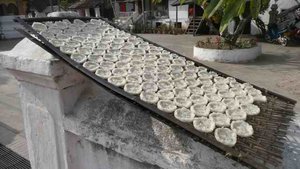
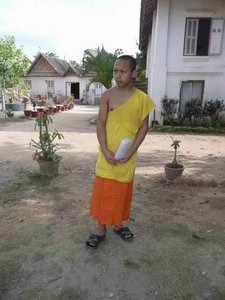 While looking around the grounds of one wat, Monk was approached by a young monk who said he’d been learning English for 6 months. Monk and the monk, whose name was Bee, chatted for 10 minutes before Bee offered to open up the temple to show Monk the Buddhas inside. On coming out, Monk was ‘stung’ by Bee for 7000 Kip as a donation toward his study costs. Monk didn’t really mind, it had been an interesting 15 minutes and he thought it was well worth the 50p he gave to Bee! Many of the young monk novices never go on to become full-blown monks, it’s often just a form of higher education for them. It seems many of them study English during their time as a monk. It’s recommended never to give one’s email address to these young monks – it can lead to a series of emails back home asking for the money to buy the latest must-have monk trainers.
While looking around the grounds of one wat, Monk was approached by a young monk who said he’d been learning English for 6 months. Monk and the monk, whose name was Bee, chatted for 10 minutes before Bee offered to open up the temple to show Monk the Buddhas inside. On coming out, Monk was ‘stung’ by Bee for 7000 Kip as a donation toward his study costs. Monk didn’t really mind, it had been an interesting 15 minutes and he thought it was well worth the 50p he gave to Bee! Many of the young monk novices never go on to become full-blown monks, it’s often just a form of higher education for them. It seems many of them study English during their time as a monk. It’s recommended never to give one’s email address to these young monks – it can lead to a series of emails back home asking for the money to buy the latest must-have monk trainers.



Luang Prabang has a bustling food market for vegetables, meat and just about anything. The market also has many ‘street food’ stalls. Now Monk has no aversion to street food, in fact, he loves the Bangkok scene and the Singapore hawker centres. However, he’s not too sure about Lao street food here in Luang Prabang. The vendors do their best to keep the flies away with their makeshift fly ‘scarecrows’ – or should it be ‘scareflies’? These comprise a bamboo stick with a plastic bag tied to the end which they wave constantly across their goods. However, the Lao people, being such a sociable bunch, can get distracted into noisy conversation with the neighbouring stall-holders, and the flies, sensing their moment of glory, move in – in swarms! The food in the process of being cooked over charcoal is safe from this invasion – the flies obviously can’t take the heat. However, other dishes such as soups, salads, sausages and meat already cooked all succumb to this onslaught. It’s good to see that the Lao stall-holders have overcome the problem of how to re-use plastic bags, but, before Monk eats ‘street’ in Laos, he thinks he’ll wait for another more high-tech solution.


On his way back to his hotel, Monk passed through the night market which starts setting up just as the sun is going down. There are so many stalls selling so much aimed at the tourist. However, even though much of the merchandise is of good quality and is locally produced, there are just not that number of tourists around to support such a large market.

At one point Monk saw a bit of a fracas going on and stopped to investigate. A small rat, the size of a large mouse, was running between, and burrowing into, the garments and textiles being laid out on mats on the ground. Eventually, after much laughter from the men, and screams from the women, the rat was caught and handed to a young boy. He delicately held it by the tail and walked up the hillside with it before placing it gently on the ground to let it run free – rattus rattus had survived another day. This respect for life, no matter how low, is an endearing characteristic of the Buddhist religion. Even Buddhist meat-eaters excuse themselves by saying the animal was dead in any case and it would be wrong not to afford it the respect of eating it. In the case of fish, which have clearly been caught purely for eating, it is said that some salve their consciences by claiming that the fish was removed from the water to save it from drowning!

Eating and drinking
On his walkabout during the day, Monk had sought out a couple of restaurants recommended as serving good Lao food and had noted their location for his evening sortie.
While monks must spend time on their devotions, Monk must spend time updating his blog. Tonight, the hotel wifi was working so Monk sat at a table by the river drinking a Beerlao while writing up his blog and making a few Skype calls back home.
By the time Nellie and Monk hit the streets, it was already 21:00. Both of the restaurants Monk had identified were closing up so he resolved to get out earlier in future. Mostly everywhere in Luang Prabang closes early and, come 23:00, all but a few places are closed and shuttered. By law, they must close by 23:30 in any case.
Monk found a reasonable restaurant on the main street and ordered fish laap, sticky rice and fried aubergines. Laap comprises either chopped-up pork, chicken, fish or beef, mixed with lime juice, garlic, onion, mint and, of course, chillis. This is served with lettuce leaves. The procedure is to take a lettuce leaf and roll it up in one’s fingers with some of the minced fish and some sticky rice. However, when raising it to one’s mouth, invariably some of the mince falls out. After a few tries, Monk perfected his own way of doing it. His trick was to place a wedge of sticky rice at either end of the roll-up with the mince sandwiched in the centre – nothing could ever escape through the sticky rice wedges. Sticky rice is a very versatile dish that could have many uses in the building trade and heavy industry. Monk feels that the economy of Laos could be catapulted into the 21st century if only the Lao people would realise the enormous potential of their national dish.
The giving of alms to the monks
January 15th 2010 – Published: January 15th 2010

5:30 saw Nellie and Monk pounding the streets of Luang Prabang looking for signs of the monks doing their morning walkabout to receive food from the townsfolk. They’d been told that the monks appeared at 6am. This morning, it seems, the monks must have been out on the town last night – it was 6:30 before a saffron robe appeared in the distance.

It was all very impressive – hundreds and hundreds of monks, one after another with their alms bowls hanging from their shoulders. The pious kneeled by the side of the road. As the monks passed by, they stopped at each, and a handful of sticky rice was placed in their bowl. They just kept coming and coming and it must have been over an hour before the final monk passed by.

At this point Nellie and Monk decided it was time to head back to the hotel for their own breakfast. Nellie posed for her breakfast photograph.

In the afternoon, they decided to go walking to the small village of Ban Chang Kong upstream on the Mekong. The hotel staff were aghast that anybody should try to walk there and insisted that the only way to go was by tuk-tuk. Regardless, Nellie and Monk walked via the bamboo bridge in the video.

In truth, it was no longer than half-an-hour’s walk although, as with his blogging, Monk does tend to meander. The round trip took about 4 hours but that included browsing in the textile and silk shops for which the village is renowned. Normally, the looms are all clunking away producing the cloth for the shops. Today, however was a full moon Buddhist holiday. One of the other crafts that the village indulges in is the production of elephant dung paper. Now, for a lady elephant like Nellie, this is all bit a distasteful so Monk skipped the shops indulging in this unseemly product in order to spare Nellie’s blushes.
Monk bought Nellie a silk scarf. Before leaving London, Monk had looked in vain for a silk or cotton bag in which to wrap Nellie while travelling. Having failed, Nellie had been forced to leave home and face the world wrapped in a bright yellow Barclays Bank cotton money bag. Monk had washed it to make sure it was clean, but it still wasn’t chic enough for a sophistcated pachyderm like Nellie.
So, from today, Nellie can now travel, with her trunk held high, wrapped in her new silk scarf.
Arriving back in Luang Prabang, Monk realised with horror that they had not yet done one of the important sightseeing tasks in Luang Prabang – climbing at sunset to the top of Mount Phusi which overlooks the town. There were a lot of steps up, and even more coming down a different way, but the views are worth it.
Eating and drinking

Tonight, Monk finally got to try the famous Luang Prabang buffalo sausage – he was impressed and, for the first time since leaving home, he ordered himself a bottle of red wine. Even though this breaks Monk’s rule about eating and drinking local, Monk feels that wine can be excused in southeast Asia because very little is produced locally and one does get a bit fed up having beer with food all the time. The wine, together with a couple of Beerlaos earlier in the evening didn’t help Monk and Nellie get up at 5:30 the next morning to meet the boat for the trip up the Mekong. Compared with Thailand, the price of wine in Laos is quite reasonable – communism suddenly doesn’t seem all that bad!
On the Mekong from Luang Prabang to Houai Say
January 17th 2010 – Published: January 20th 2010
At 7am, the boat ‘Pak Ou’ cast off from the pier in Luang Prabang and headed upriver on its 330 kilometer journey which would take the next 2 full days, its destination, Houai Say on the Lao side of the river opposite Chiang Khong in Thailand.


There are three popular ways to travel on the Mekong river between Houai Say and Luang Prabang, or vice versa. If you need to do the journey in one day, and you don’t fear for your life, you can take the speedboat, also known as the ‘jetboat’. These boats look more like a rowing boat with a car engine strapped to the back and propel up to 8 people at incredible speed and deafening noise. Passengers are supposed to don lifejackets and crash helmets, but during Monk’s journey, he saw several where the passenegers wore neither. The danger comes from several sources; debris such as tree trunks, hidden rocks, high waves, rapids and whirlpools. The Mekong flows fast and once in the water, even the best swimmer would struggle against the currents. Apparently, the journey, while thrilling, is also exhausting because of the noise and constant bumping. It takes 8 or 9 hours from one town to the other but on arrival, you’d probably need to crash out for most of the next day so nothing much would be gained.
Much better to do things the Lao way, slowly and without rushing, by taking the safer slow-boat. These boats are supposed to carry up to 70 people and take 2 days to do the journey, forcing an overnight stop at the town of Pakbeng midway. There are all sorts of stories about slow-boat overcrowding with tales of passengers being put in the engine room. At Chiang Khong on the Thai side, one of the big sellers in the shops, is a cushion for a more comfortable journey on the hard seats of the slow-boats. When a slow-boat docks at Pakbeng, a mad rush takes place to grab the best available room find for the night.

The third way is to take one of the more luxurious slow-boats run by the Luang Say company. These steel-hulled boats take up to 40 people and have sofas and other comfortable seating on deck. Breakfast, lunch and drinks are served on-board. It was this boat that Monk first booked for him and Irene’s trip planned for February 2009, When booking this time, he was tempted to ‘rough it’ on the normal slow-boat but decided to stick to Irene’s original choice. The stopover at Pakbeng, in the Luang Say Lodge, is included in the price. Each room is an individual wooden, Lao-style cabin linked via wooden walkways to the central lodge – comfort combined with tradition. Dinner and breakfast are provided at the lodge.

The staff on the boat are excellent and Luang Say also provide a knowledgable local guide for the duration of the journey who is able to give passengers more insight into the sights, people and stops along the way. It’s all a bit more expensive, but it does make for an unforgettable experience rather than just a way to get from A to B, or rather, from LP to HS.
The Mekong is a truly magnificent river. It starts high up on the Tibetan plateau and meanders over 4000 kilometers on its way down through China, Myanmar, Laos, Cambodia and Vietnam. Even relatively far upstream from Luang Prabang to Houai Say, the river is very wide for most of the journey. It runs so fast. All along the way, peering overboard, one sees whirlpools and ‘boiling’ water where the river is coursing over the uneven river bed. In places, the whirlpools resemble inverted tornados maybe half a meter deep. Even on the relatively peaceful stretches, one gets the impression that the river is rushing past in its haste to get to the sea.

The surrounding landscape constantly changes and Monk found himself moving from one side of the boat to the other so as not to miss any of the spellbinding scenery. Now, steep-sided sheer rock mountains dropping down into the river. Then, dense green jungle covering the banks. In the upper reaches, wide meadows looking almost like stretches of the Thames were it not for the mountains looming in the distance. Other stetches evoking memories of the Italian lakes. Wonderful fine, golden sand beaches which would grace any Caribbean island. And rocks – all the way along the river – rocks. Not just near the banks but anywhere and everywhere on the river – treacherous for an inexperienced boatman.


From up on the bow of the boat, one sees the turbulence of the river and the obstacles approaching. It is only from this viewpoint that one apperciates the skill of the captain in knowing just where to guide the boat – not always on the seemingly most obvious course. We pass through so many rapids – the captain steering the boat to find the safest way through, sometimes slaloming sideways and appearing to head perilously toward jagged rocks that would certainly cause severe damage even to the Pak Ou’s steel hull.
We pass small wooden-housed villages high up on the banks at this time of year which later on will be at the water’s edge. The level of the river can vary by up to 8 meters after the rains come. The villagers take advantage of the low river and grow short-season crops such as peanuts on the exposed banks. Children from the villages, shout and wave as Pak Ou passes by while, nearby, herds of buffalo enjoy the grazing by the water’s edge. When the river is low, villagers pan for tiny specks of gold washed down from miles upstream and dumped as the river level has fallen.
And all the time, Pak Ou ploughs relentlessly onward to meet her immutable rendezvous at Pakbeng before nightfall turns the river into a no-go zone.
The boat makes 2 stops on the first day, one at its namesake Pak Ou caves, a Buddhist holy shrine, accessible only from the river, where thousands of Buddha statues have been placed over the centuries. The other stop is at Bor, a small riverside village of wooden hits and mud streets. The village was at one time renowned for the making of earthenware jars. These days, it specialies in the filling of them – with locally distilled Laolao rice whisky. Monk sampled the Laolao straight from the spout of the still.
We arrived at Pakbeng around 6pm and by 9:30pm most passengers had retired to their huts leaving Monk as the last, busy writing his blog. It had been a long day and the boat was set to depart at 7am for the next leg of its journey.

The Luangsay Lodge lies 1km outside Pakbeng village in a rural setting. The animal calls during the night made Nellie and Monk feel as though they were back in Nellie’s home in the thick of the jungle – an enchanting night.


The journey next day took us through yet more scenic stretches of the river and Pak Ou stopped at a village populated by the Khamu people, one of the many Lao minority groups. This village, like most of the riverside villages we had passed, is totally isolated and accessible only by river. When we arrived, the village was in the middle of a 2-day wedding celebration. The village people were so friendly to Pak Ou’s passengers and Monk was invited to join the wedding group for toasts to the bride and groom – Laolao whisky of course. The cynical might suppose that this was all a tourist set-up, but Monk, who is very sensitive to such stunts, was touched by the authenticity of the villagers’ welcome – there wasn’t even anything there for sale that we vistors could buy.
After another magical day on the river, Pak Ou finally tied up at her berth in Houai Say and we were thrown back into the real word – Lao exit control, longtail boat to ferry us across the river from Laos to Chiang Khong in Thailand and then form-filling and queuing at Thai immigration. Nellie and Monk had made friends during the trip, especially with Brigit, Claudia and Ingrid. We all wished each other goodbye, good luck, and safe travels. They especially said goodbye to Nellie.
Monk and Nellie stayed at the Namkhong Riverside Hotel tonight. It’s probably the best hotel in Chiang Khong but not exactly luxurious rooms – still at 1000 baht (about £20) one can’t expect The Oriental. If you fetch up in Chiang Khong, Monk recommends it as a reasonable and clean place to stay.
 Leave a comment about this comment
Leave a comment about this commentCopyright ©2010-2020 Nellie and Monk
